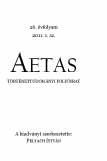Hadműveleti szintű áttörés az olasz fronton 1917. október – november
Operational-level breakthrough in the Italian front in October-November 1917
Author(s): Csaba HorváthSubject(s): History
Published by: AETAS Könyv- és Lapkiadó Egyesület
Summary/Abstract: The military strategic assessments of some of the events of World War I, or the Great War contain such military experiences to this day, which are worth discussing from time to time. The military operations that took place between 1914 and 1918 can be divided, according to their types, into two distinct periods. The first is the so called “mobile period”, when the parties wanted to achieve victory through attacks hoping to win the war by the time the leaves fall. But there were no quick victories. The second was the period of “trench warfare”, where the key to victory was breaking through the entrenched enemy lines. Breakthrough could be an initial success, building on which they hoped to win the war. Because of that, from 1915, all forces, means and methods were mobilized to achieve this goal. The chemical warfare agent (gas) released on 22 April 1915 at Ypres, the widespread use of tanks, the development of assault techniques, all served the purpose of breakthrough. All these naturally resulted in some successful attempts. The Gorlice-Tarnów Offensive or the breakthrough between Lutsk and Chernivtsi led by the Russian general Brusilov signaled that the parties had already found the methods and technical possibilities required for the successful execution of breakthroughs. Though, without shock troops, they could not expand their success, these examples were progressive developments in military strategy. On 24 October 1917 at Caporetto, the Central Powers launched one of the best organized breakthroughs. They were aware of the organization, location and activity of the Italian forces, properly assessed the terrain and carefully planned the grouping of the troops. The direction of the central attack was well-chosen, while the well thought-out and quick decisions also caught the slowly reacting Italian command by surprise. Opposing the traditional theory of mountain warfare,the attacking forces followed a new method. Instead of breaking through enemy defenses at the mountaintops and ridges, they advanced in the valleys. This impeded the free maneuvering of the defenders while facilitated the advancement of the attackers. The tactic required a great deal of artillery as well as well-orchestrated cooperation between the combat arms. But because of the poor performance of vehicle-based logistics they could not build upon the success. The few trucks available could only transport the most indispensable materials to the field, which was not enough for maintaining the momentum of the attack. This operation was another proof that in a modern environment it was not possible to build operational logistics solely on horse-drawn baggage trains. In this respect, the Allies were far superior than the Central Powers.
Journal: AETAS - Történettudományi folyóirat
- Issue Year: 2011
- Issue No: 1
- Page Range: 25-43
- Page Count: 19
- Language: Hungarian

